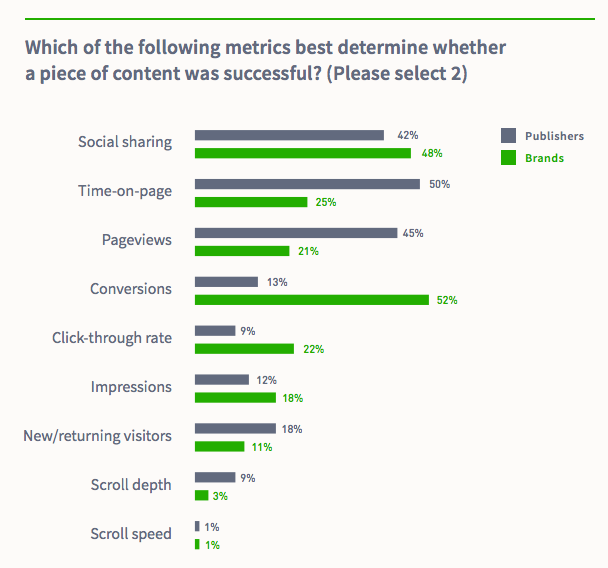Should Publishers Be More Focused on Conversions?

Over half of brands (52%) consider conversions to be the most important metric to determine whether a piece of content was successful. By comparison, only 13.3% of publishers find conversions a useful benchmark of success, favoring instead time-on-page (50%), pageviews (45%), and social sharing (41.7%).
 These metrics highlight a difference in the goals of the two kinds of organizations. In general, publishers are more concerned with users reading or viewing their content. For brands, content aligns with the overall strategy of driving customers to a product.
However, publishers might be able to take a page out of brands’ playbook when it comes to conversions, particularly for implementing and tracking monetization.
Our research done in partnership with Digiday’s CUSTOM studio underscores that publishing professionals often find themselves thinking from two perspectives. When it comes to paid efforts, editors also need to consider more traditionally business-side concerns.
These metrics highlight a difference in the goals of the two kinds of organizations. In general, publishers are more concerned with users reading or viewing their content. For brands, content aligns with the overall strategy of driving customers to a product.
However, publishers might be able to take a page out of brands’ playbook when it comes to conversions, particularly for implementing and tracking monetization.
Our research done in partnership with Digiday’s CUSTOM studio underscores that publishing professionals often find themselves thinking from two perspectives. When it comes to paid efforts, editors also need to consider more traditionally business-side concerns.
“I’m the editor of a subscription-based video recipe app. I have a website; I want conversions. So on some level, how do we get people into the product and get them to subscribe? This is the fundamental metric of anything we do.” —study participantMeasuring conversions could help publishers serve these business-side concerns without making sacrifices to editorial strategy.
Defining Conversions in the Context of Content
Content marketers in particular are no stranger to conversions. A conversion happens when a visitor to a website takes a desired action. That action can be any number of things—filling out a form, downloading content, subscribing to a newsletter, or making a purchase. The flexibility of what constitutes a conversion simultaneously lends an advantage and presents complications. With a multitude of choices, how do you know what exactly to measure—especially operating as a publisher, not necessarily as a marketer? In addition, marketers have long dealt with the issue of “attribution modeling,” or, how do you know what exactly caused that conversion? Defining what constitutes a conversion in the context of goals is key. As one brand participant says, “It’s [about] understanding what’s the business objective, the marketing objective. What are the behavioral outcomes that you want to see from the audience based on those objectives? A lot of my job is really level setting and resetting goals.” A #MetricShift chat hosted by MediaShift pinpointed conversions as an underrated metric. Jason Alcorn predicted publishers will begin to pay more attention to “conversion to known user” in the near future, with subscribers as one example.//platform.twitter.com/widgets.js The Telegraph has focused its strategy on driving subscriptions. Digiday reports that the newspaper has seen an increase in subscriptions since instituting a paywall.Conversions. Bet that number will be way higher next year. #MetricShift https://t.co/ib9YbTwlDh
— Jason Alcorn (@jasonalcorn) February 24, 2017
“The number of new people signing up to subscribe to The Telegraph on any given day has grown 300 percent since the newspaper put 20 percent of its content behind a hard paywall last November.” —DigidayPreviously, subscriptions strategy was more separate from editorial strategy, but now, “The Telegraph’s editors get full ownership of what content is commissioned for Premium and what is made available for open access.” Editors analyze audience data to make these decisions and to understand which articles are driving subscriptions. Measuring conversions in this way unites business and editorial goals, rather than setting them apart, or even seeing them as at odds with one another.
Set Goals, Measure Success, and “Repurpose the Hell Out of It”
The real takeaway publishers can learn from brands when it comes to conversions is the necessity of defining goals and deciding what success is from the outset. Publishers may find that discussing what qualifies as a conversion for their team can lead to a more unified overall strategy. Survey responses suggest that conversions aren’t necessarily top-of-mind for publishers at the organization level. Publishers are only asked to predict or report conversions 5% of the time. However, as in the example of The Telegraph, there’s interesting potential when teams restructure around the common goal of conversions.
However, as in the example of The Telegraph, there’s interesting potential when teams restructure around the common goal of conversions.
“It’s sort of a chicken and egg discussion. If the question is what’s the best metric, you have to lay out what the goal of the particular piece of content is before you can say, ‘Here’s how it should be measured.’” —brand-side study participantAnd once you set a goal, measure, and find what works—according to a brand marketer—you “repurpose the hell out of it…trying to recreate that effect.” Curious how the way your team uses analytics compares to that of other publishers and brands? Read the full Digiday report to get a sense of how the industry’s approach to data analytics is evolving.